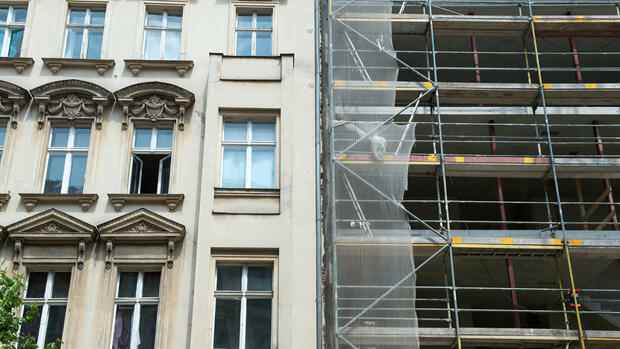Berlin According to information from the Handelsblatt, the federal government has agreed on key points to relieve tenants of CO2 pricing. “With the speedy agreement, the government is proposing a model with seven stages that meets the requirements for a fair distribution of CO2 costs depending on the condition of the building,” said Bernhard Daldrup, spokesman for construction and housing policy for the SPD parliamentary group in the Bundestag .
The financial participation of the tenants depends on the energetic condition of the building, explained Daldrup. “The more CO2 it emits, the higher the share of landlords.”
The Federal Ministry of Economics and Climate (BMWK) headed by department head Robert Habeck (Greens) is currently working on details for such a staged model. According to BMWK circles, the aim is to provide incentives for energy-related renovation. The worse a building is insulated and the older the heating system, for example, the higher the CO2 load should be for the landlord – and the greater the relief for tenants.
In these cases, so the argument goes, the tenant often suffers from high energy costs due to poor insulation and insulation of the apartment, but has no remedy himself. Conversely, a landlord who is renovating and whose building has a high energy quality can also pass on costs. Then the landlord took measures to keep energy costs within limits, for example because the apartment and windows are well insulated.
Top jobs of the day
Find the best jobs now and
be notified by email.
According to the previous legal situation, the tenants alone bear the CO2 costs via the service charge bill. Last year, the old federal government agreed to split the price of CO2 in half, but was slowed down by the Union faction in the Bundestag.
Union demands “low-bureaucracy and practical” regulation
“With the emerging agreement, the division of the CO2 costs in half seems off the table,” said Jan-Marco Luczak, construction and housing policy spokesman for the Union parliamentary group, now. “That’s good, because such a blanket regulation would have meant a fundamental breach of the polluter pays principle. It would have been neither fair nor just because landlords have no influence whatsoever on the consumption behavior of their tenants. The steering effect of CO2 pricing would also have largely fizzled out.”
A graded system based on the energetic condition of the building is better suited to have a steering effect on use and necessary investments in energetic renovations, Luczak continued. “We have to look at the details very carefully now. At first glance, seven efficiency classes appear very complicated.” Luczak called for a “low-bureaucracy and practical” regulation. “The traffic light has to deliver that now.”
>> Read here: Taxes, rent and heating costs: This is what homeowners, tenants and builders can expect
The coalition agreement between the SPD, Greens and FDP stipulates that there should be a “fair distribution” of the CO2 price to be paid in addition to the heating costs between landlords on the one hand and tenants on the other. As of June 1, 2022, a tiered model based on building energy classes is to be introduced.
The tenants’ association considers a tiered model to be suitable in principle for providing relief. “However, only if tenants are completely exempt from the additional costs in the buildings with the poorest energy efficiency,” said the federal director of the association, Melanie Weber-Moritz. “These tenants suffer from the highest energy costs and their behavior has little influence on the amount of their energy bill.” The legislature must take this into account.
Consumer advocates insist on splitting the costs equally
According to the tenants’ association, the distribution of costs must follow the logic that landlords in the buildings with the poorest energy efficiency should be prompted to carry out renovations as a result of the CO2 price. The association criticizes that this is not provided for in the government’s regulatory concept. “Rather, tenants should contribute at least ten percent to the additional costs, even in houses with old oil heating systems that emit a correspondingly large amount of CO2.”
According to figures from the tenants’ association, the additional costs for a model household in an unrenovated apartment alone due to the CO2 tax amount to 130 euros (gas) or 190 euros (heating oil) in 2022 and will increase to 238 euros (gas) or 350 euros (heating oil) annually by 2025.
The SPD politician Daldrup is convinced that the higher cost burden in energetically “poor” buildings creates incentives for the landlord to modernize the building. “We are thus keeping our agreement from the coalition agreement, according to which there should be a fair division between landlords and tenants.”
>> Read here: This is how tenants come out of contracts despite the waiver of termination
The FDP is also satisfied. “A phased model helps tenants and landlords,” said Daniel Föst, spokesman for construction and housing policy for the FDP parliamentary group. “By doing so, we create incentives to use less energy and also to renovate. This reduces consumption in the long term and we avoid costs overall.”
Meanwhile, consumer advocates insist on splitting the increased costs caused by the CO2 price in half. “It is crucial that the tenants are relieved of at least 50 percent in the measure planned by the federal government to split the CO2 price,” said the head of the Energy and Building team at the Federal Association of Consumer Organizations (VZBV), Thomas Engelke Handelsblatt.
However, according to Daldrup, this variant should only be available if the staged model does not succeed by June 1st. Then, from June 1, 2022, the increased costs due to the CO2 price would be shared equally between landlords and tenants.
More: The crux of the heat transition – what makes the switch to climate-friendly heating systems so difficult
